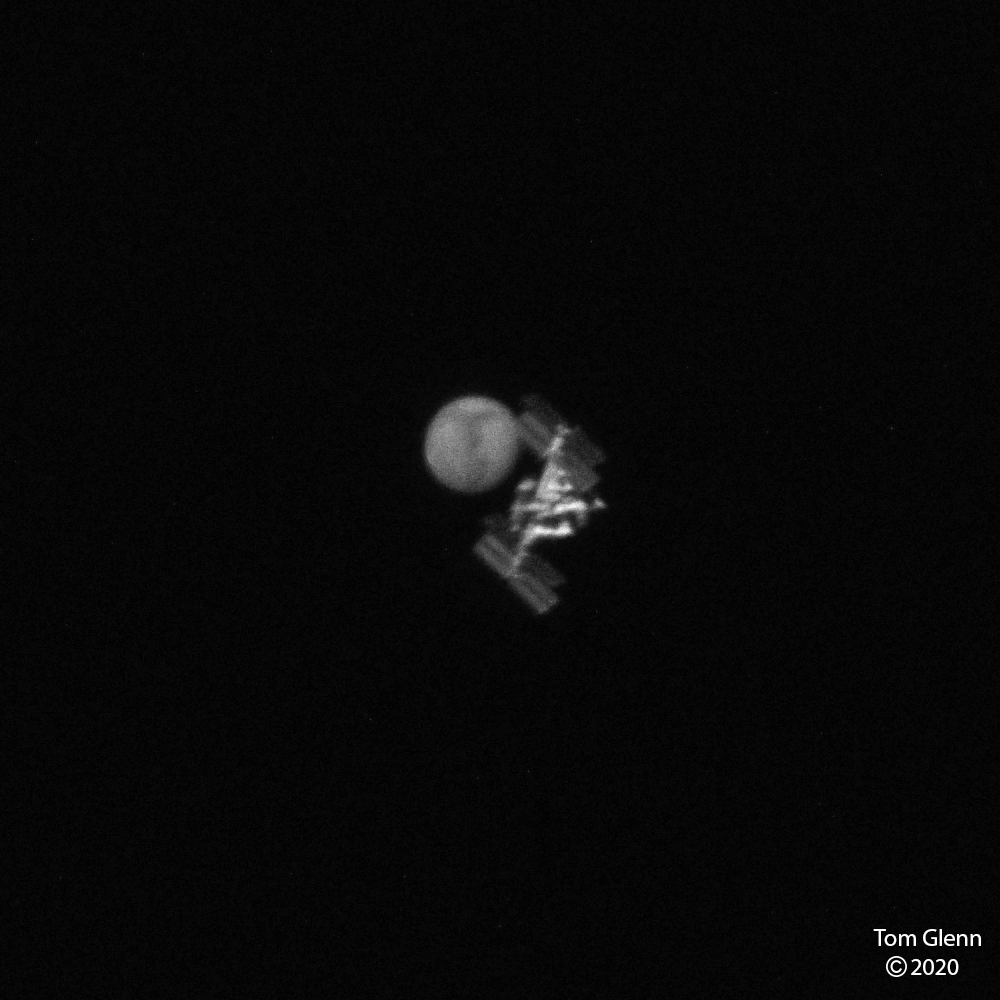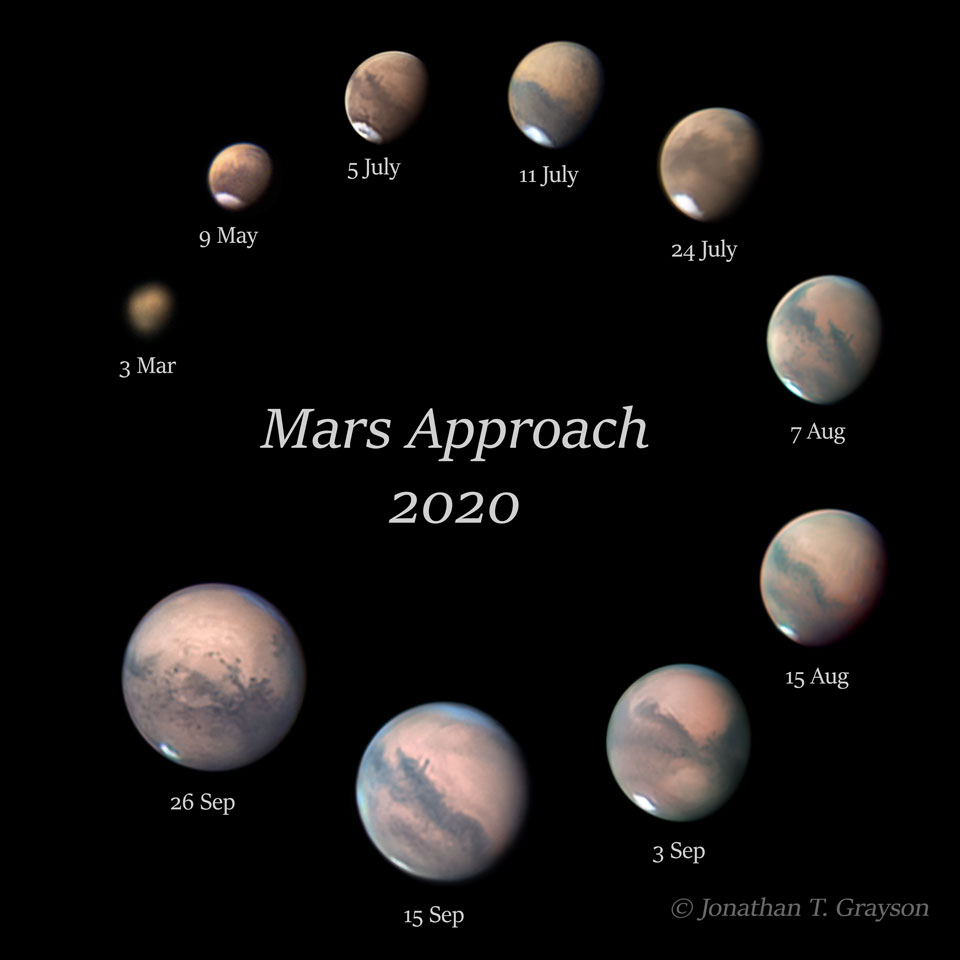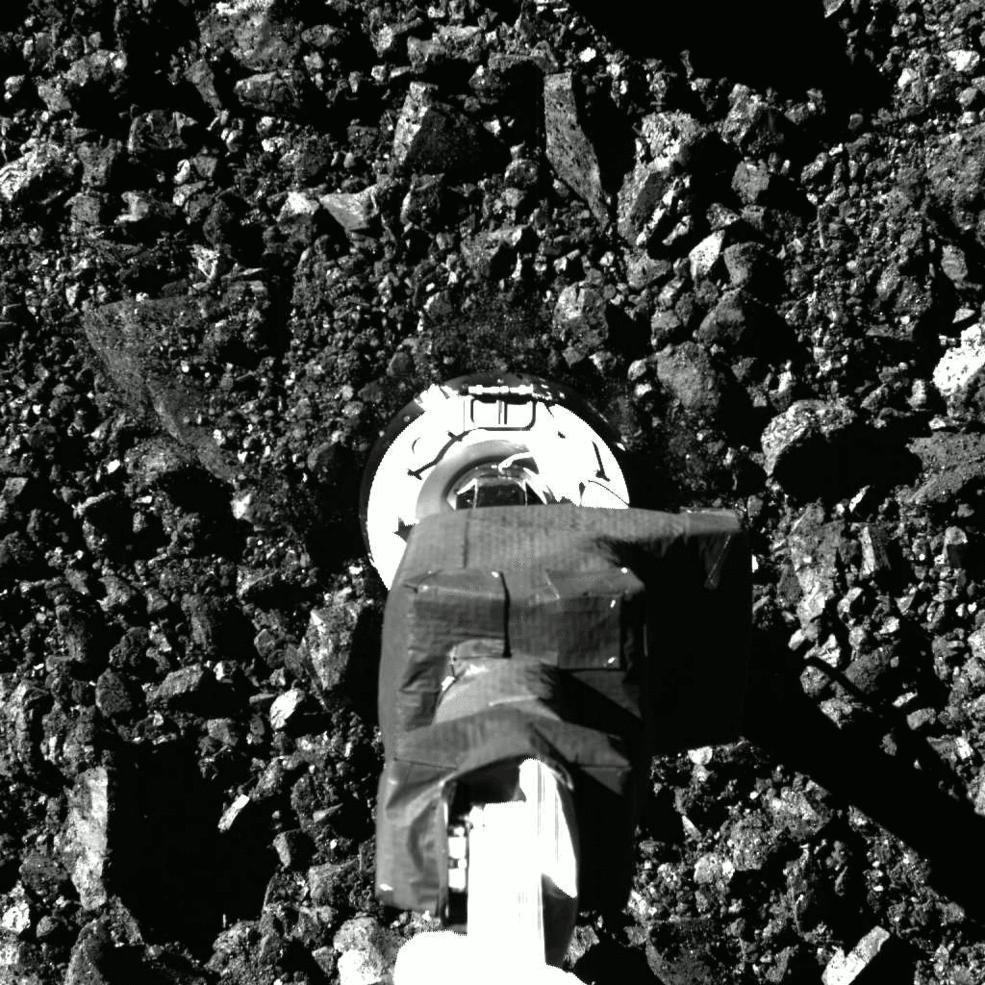Navigation
Install the app
How to install the app on iOS
Follow along with the video below to see how to install our site as a web app on your home screen.
Note: This feature may not be available in some browsers.
More options
You are using an out of date browser. It may not display this or other websites correctly.
You should upgrade or use an alternative browser.
You should upgrade or use an alternative browser.
The Night Sky
- Thread starter Roccus7
- Start date
This guy has us looking at Mars beaten by a light year!!! ISS photobombing (transiting) Mars!!!

Grab the scopes tonight and checkout Mars!!!

Explanation: Look to the east just after sunset tonight and you'll see a most impressive Mars. Tonight, Mars will appear its biggest and brightest of the year, as Earth passes closer to the red planet than it has in over two years -- and will be again for another two years. In a week, Mars will be almost as bright -- but at opposition, meaning that it will be directly opposite the Sun. Due to the slightly oval shape of the orbits of Mars and Earth, closest approach and opposition occur on slightly different days. The featured image sequence shows how the angular size of Mars has grown during its approach over the past few months. Noticeably orange, Mars is now visible nearly all night long, reflecting more sunlight toward Earth than either Saturn or Jupiter. Even at its closest and largest, though, Mars will still appear over 100 times smaller, in diameter, than a full moon.

Explanation: Look to the east just after sunset tonight and you'll see a most impressive Mars. Tonight, Mars will appear its biggest and brightest of the year, as Earth passes closer to the red planet than it has in over two years -- and will be again for another two years. In a week, Mars will be almost as bright -- but at opposition, meaning that it will be directly opposite the Sun. Due to the slightly oval shape of the orbits of Mars and Earth, closest approach and opposition occur on slightly different days. The featured image sequence shows how the angular size of Mars has grown during its approach over the past few months. Noticeably orange, Mars is now visible nearly all night long, reflecting more sunlight toward Earth than either Saturn or Jupiter. Even at its closest and largest, though, Mars will still appear over 100 times smaller, in diameter, than a full moon.
CELLFISH
Well-Known Angler
Grab the scopes tonight and checkout Mars!!!

Explanation: Look to the east just after sunset tonight and you'll see a most impressive Mars. Tonight, Mars will appear its biggest and brightest of the year, as Earth passes closer to the red planet than it has in over two years -- and will be again for another two years. In a week, Mars will be almost as bright -- but at opposition, meaning that it will be directly opposite the Sun. Due to the slightly oval shape of the orbits of Mars and Earth, closest approach and opposition occur on slightly different days. The featured image sequence shows how the angular size of Mars has grown during its approach over the past few months. Noticeably orange, Mars is now visible nearly all night long, reflecting more sunlight toward Earth than either Saturn or Jupiter. Even at its closest and largest, though, Mars will still appear over 100 times smaller, in diameter, than a full moon.
MARS tonight... cellie...
.
View attachment 25529
Thats coolNever seen this before, the "Giant Squid" nebula which is inside the "Flying Bat" nebula...
View attachment 25566
Orionids Meteor Shower 2020: Watch It Peak in Night Skies
All year long as Earth revolves around the sun, it passes through streams of cosmic debris. The resulting meteor showers can light up night skies from dusk to dawn, and if you’re lucky you might be able to catch a glimpse.
The next shower you might be able to see is known as the Orionids. Active from Oct. 2 to Nov. 7, it is expected to be at its peak from Monday night into Tuesday morning, or Oct. 19 to 20.
The Orionids are an encore to the Eta Aquariid meteor shower, which peaks in May. Both come from cosmic material spewed from Halley’s comet. Because that celestial celebrity orbits past Earth once every 76 years, the showers this weekend are your chance to view the comet’s leftovers until the real deal next passes by in 2061.
During a normal peak, you might be able to observe 10-20 streaks. According to the International Meteor Organization, viewing conditions could be favorable as the moon is far from being full.
Where meteor showers come from
If you spot a meteor shower, what you’re usually seeing is an icy comet’s leftovers that crash into Earth’s atmosphere. Comets are sort of like dirty snowballs: As they travel through the solar system, they leave behind a dusty trail of rocks and ice that lingers in space long after they leave. When Earth passes through these cascades of comet waste, the bits of debris — which can be as small as grains of sand — pierce the sky at such speeds that they burst, creating a celestial fireworks display.A general rule of thumb with meteor showers: You are never watching the Earth cross into remnants from a comet’s most recent orbit. Instead, the burning bits come from the previous passes. For example, during the Perseid meteor shower you are seeing meteors ejected from when its parent comet, Comet Swift-Tuttle, visited in 1862 or earlier, not from its most recent pass in 1992.
That’s because it takes time for debris from a comet’s orbit to drift into a position where it intersects with Earth’s orbit, according to Bill Cooke, an astronomer with NASA’s Meteoroid Environment Office.
How to watch
The best way to see a meteor shower is to get to a location that has a clear view of the entire night sky. Ideally, that would be somewhere with dark skies, away from city lights and traffic. To maximize your chances of catching the show, look for a spot that offers a wide, unobstructed view.Bits and pieces of meteor showers are visible for a certain period of time, but they really peak visibly from dusk to dawn on a given few days. Those days are when Earth’s orbit crosses through the thickest part of the cosmic stream. Meteor showers can vary in their peak times, with some reaching their maximums for only a few hours and others for several nights. The showers tend to be most visible after midnight and before dawn.
It is best to use your naked eye to spot a meteor shower. Binoculars or telescopes tend to limit your field of view. You might need to spend about half an hour in the dark to let your eyes get used to the reduced light. Stargazers should be warned that moonlight and the weather can obscure the shows. But if that happens, there are usually meteor livestreams like the ones hosted by NASA and by Slooh.
The International Meteor Organization lists a variety of meteor showers that can be seen in 2020. Or you can find more information about some of the showers this year that are most likely to be visible below:
After circling asteroid Bennu for a year looking for "the spot," probe OSIRIS-REx made a successful capture of material from the asteroid. Now we'll have to wait until 2023 for this sample to make it back the 200 million miles to earth, ending a mission which began in 2016. Until we have Warp Drive, Hyperdrive or Ludicrous Speed, space adventures are long-term voyages...


Damn, Osiris' eyes were bigger than its stomach...
 pressherald.com/2020/10/23/asteroid-samples-are-escaping-from-jammed-nasa-spacecraft/
pressherald.com/2020/10/23/asteroid-samples-are-escaping-from-jammed-nasa-spacecraft/
By MARCIA DUNN Associated PressOctober 24, 2020

In this image taken from video released by NASA, the Osiris-Rex spacecraft touches the surface of asteroid Bennu on Tuesday. NASA via AP
CAPE CANAVERAL, Fla. — A NASA spacecraft is stuffed with so much asteroid rubble from this week’s grab that it’s jammed open and precious particles are drifting away in space, scientists said Friday.
Scientists announced the news three days after the spacecraft named Osiris-Rex briefly touched asteroid Bennu, NASA’s first attempt at such a mission.
The mission’s lead scientist, Dante Lauretta of the University of Arizona, said Tuesday’s operation 200 million miles away collected far more material than expected for return to Earth — in the hundreds of grams. The sample container on the end of the robot arm penetrated so deeply into the asteroid and with such force, however, that rocks got sucked in and became wedged around the rim of the lid.
Scientists estimate the sampler pressed as much as 19 inches (48 centimeters) into the rough, crumbly, black terrain.
“We’re almost a victim of our own success here,” Lauretta said at a hastily arranged news conference.
Lauretta said there is nothing flight controllers can do to clear the obstructions and prevent more bits of Bennu from escaping, other than to get the samples into their return capsule as soon as possible.
So, the flight team was scrambling to put the sample container into the capsule as early as Tuesday — much sooner than originally planned — for the long trip home.
“Time is of the essence,” said Thomas Zurbuchen, chief of NASA’s science missions.
This is NASA’s first asteroid sample-return mission. Bennu was chosen because its carbon-rich material is believed to hold the preserved building blocks of our solar system. Getting pieces from this cosmic time capsule could help scientists better understand how the planets formed billions of years ago and how life originated on Earth.
Scientists were stunned — and then dismayed — on Thursday when they saw the pictures coming from Osiris-Rex following its wildly successful touch-and-go at Bennu two days earlier.
A cloud of asteroid particles could be seen swirling around the spacecraft as it backed away from Bennu. The situation appeared to stabilize, according to Lauretta, once the robot arm was locked into place. But it was impossible to know exactly how much had already been lost.
The requirement for the $800 million-plus mission was to bring back a minimum 2 ounces (60 grams).
Regardless of what’s on board, Osiris-Rex will still leave the vicinity of the asteroid in March — that’s the earliest possible departure given the relative locations of Earth and Bennu. The samples won’t make it back until 2023, seven years after the spacecraft rocketed away from Cape Canaveral.
Osiris-Rex will keep drifting away from Bennu and will not orbit it again, as it waits for its scheduled departure.
Because of the sudden turn of events, scientists won’t know how much the sample capsule holds until it’s back on Earth. They initially planned to spin the spacecraft to measure the contents, but that maneuver was canceled since it could spill even more debris.
“I think we’re going to have to wait until we get home to know precisely how much we have,” Lauretta told reporters. “As you can imagine, that’s hard. … But the good news is we see a lot of material.”
Japan, meanwhile, is awaiting its second batch of samples taken from a different asteroid, due back in December.
Asteroid samples are escaping from jammed NASA spacecraft
By MARCIA DUNN Associated PressOctober 24, 2020

In this image taken from video released by NASA, the Osiris-Rex spacecraft touches the surface of asteroid Bennu on Tuesday. NASA via AP
CAPE CANAVERAL, Fla. — A NASA spacecraft is stuffed with so much asteroid rubble from this week’s grab that it’s jammed open and precious particles are drifting away in space, scientists said Friday.
Scientists announced the news three days after the spacecraft named Osiris-Rex briefly touched asteroid Bennu, NASA’s first attempt at such a mission.
The mission’s lead scientist, Dante Lauretta of the University of Arizona, said Tuesday’s operation 200 million miles away collected far more material than expected for return to Earth — in the hundreds of grams. The sample container on the end of the robot arm penetrated so deeply into the asteroid and with such force, however, that rocks got sucked in and became wedged around the rim of the lid.
Scientists estimate the sampler pressed as much as 19 inches (48 centimeters) into the rough, crumbly, black terrain.
“We’re almost a victim of our own success here,” Lauretta said at a hastily arranged news conference.
Lauretta said there is nothing flight controllers can do to clear the obstructions and prevent more bits of Bennu from escaping, other than to get the samples into their return capsule as soon as possible.
So, the flight team was scrambling to put the sample container into the capsule as early as Tuesday — much sooner than originally planned — for the long trip home.
“Time is of the essence,” said Thomas Zurbuchen, chief of NASA’s science missions.
This is NASA’s first asteroid sample-return mission. Bennu was chosen because its carbon-rich material is believed to hold the preserved building blocks of our solar system. Getting pieces from this cosmic time capsule could help scientists better understand how the planets formed billions of years ago and how life originated on Earth.
Scientists were stunned — and then dismayed — on Thursday when they saw the pictures coming from Osiris-Rex following its wildly successful touch-and-go at Bennu two days earlier.
A cloud of asteroid particles could be seen swirling around the spacecraft as it backed away from Bennu. The situation appeared to stabilize, according to Lauretta, once the robot arm was locked into place. But it was impossible to know exactly how much had already been lost.
The requirement for the $800 million-plus mission was to bring back a minimum 2 ounces (60 grams).
Regardless of what’s on board, Osiris-Rex will still leave the vicinity of the asteroid in March — that’s the earliest possible departure given the relative locations of Earth and Bennu. The samples won’t make it back until 2023, seven years after the spacecraft rocketed away from Cape Canaveral.
Osiris-Rex will keep drifting away from Bennu and will not orbit it again, as it waits for its scheduled departure.
Because of the sudden turn of events, scientists won’t know how much the sample capsule holds until it’s back on Earth. They initially planned to spin the spacecraft to measure the contents, but that maneuver was canceled since it could spill even more debris.
“I think we’re going to have to wait until we get home to know precisely how much we have,” Lauretta told reporters. “As you can imagine, that’s hard. … But the good news is we see a lot of material.”
Japan, meanwhile, is awaiting its second batch of samples taken from a different asteroid, due back in December.
wader
Well-Known Angler
Blue moon to grace Halloween night sky for the first time in 76 years
A full blue moon hovered over the Halloween 2020 night sky. “Everybody gets all romantic about the sunrise and the sunset but a moonrise and a moonset can be very dramatic and exciting,” astronomer Jackie Faherty tells Yahoo Life.
JackPrintMD
Well-Known Angler
Once in a milky way supernova

7 planets in solar system will be visible in the night sky this week
It's going to be a stellar show.
That's a shame - it was in the Jodie Foster film Contact

 www.yahoo.com
www.yahoo.com

Huge Puerto Rico radio telescope, already damaged, collapses
A huge, already damaged radio telescope in Puerto Rico that has played a key role in astronomical discoveries for more than half a century completely collapsed on Tuesday. The telescope's 900-ton receiver platform fell onto the reflector dish more than 400 feet below. The U.S. National Science...
Many key discoveries made there. I used to go to PR to work with folks at a plant there which was close to Arecibo. Can't believe it's no more...That's a shame - it was in the Jodie Foster film Contact

Huge Puerto Rico radio telescope, already damaged, collapses
A huge, already damaged radio telescope in Puerto Rico that has played a key role in astronomical discoveries for more than half a century completely collapsed on Tuesday. The telescope's 900-ton receiver platform fell onto the reflector dish more than 400 feet below. The U.S. National Science...www.yahoo.com
Latest articles
-
Recreational Anglers Deserve an ApologyI've Been Saying This All Along: Recreational Anglers Deserve an Apology The data is finally in...
- george
- Updated:
- 6 min read
-
Abu Garcia's Beast SeriesAbu Garcia's Beast Series: Revolutionary Equipment for the Modern Swimbait Revolution October...
- george
- Updated:
- 6 min read
-
World's Lightest Spinning ReelGame-Changer or Gimmick? The Daiwa LUVIAS ST Claims to Be the World's Lightest Spinning Reel An...
- george
- Updated:
- 4 min read
-
New York Fluked Itself!Fluke Management in 2025: Regulators Got It Wrong Halfway through this season New York anglers...
- george
- Updated:
- 2 min read
-
Hunting Stripers and Blues from Rockaway Beach to Moriches InletThe Western Run: Hunting Stripers and Blues from Rockaway Beach to Moriches Inlet By: A Die-Hard...
- george
- Updated:
- 10 min read
